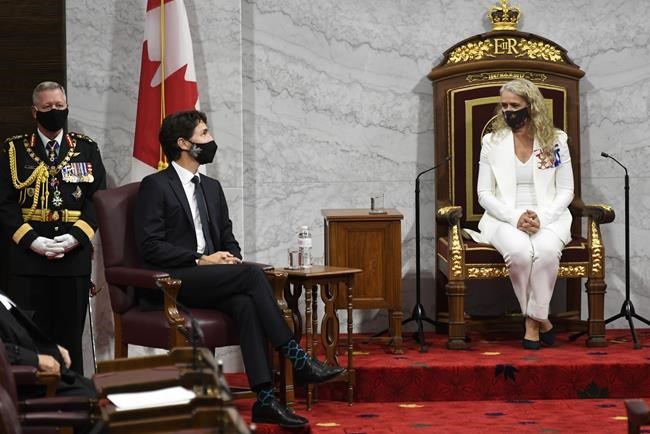
Gov. Gen. Julie Payette and Prime Minister Justin Trudeau wait during the throne speech in the Senate chamber in Ottawa on Wednesday, Sept. 23, 2020. THE CANADIAN PRESS/Adrian Wyld
Republished September 23, 2021 - 2:12 PM
Original Publication Date September 23, 2021 - 12:06 PM
OTTAWA - Experts warn the Liberals’ promise to legislate safety in long-term care will have to come with more money if new national care standards are going to fix what’s broken in the system.
The COVID-19 pandemic shone a glaring spotlight on the already tenuous ability of staff and loved ones to provide care inside many retirement and nursing homes across the country.
In the 2020 throne speech, the government promised to work with provinces and territories to set new, national standards for long-term care — a process that was launched through the Health Standards Organization and the Canadian Standards Association in March 2021.
In fact, national HSO standards for long-term care already exist and are used as the accreditation criteria for about 58 per cent of all homes in Canada, according to Dr. Samir Sinha, chair of one of the technical committees working to rewrite those standards.
He said in Quebec, all homes must adhere to the existing national standards as a condition of their accreditation.
Sinha said the first draft of the new standards, which are set to be publicly released at the end of the year, aim to promote a better working environment for staff and ensure high-quality care for residents.
“We have an excellent committee that really is coming together to kind of say, ‘This is what excellent long-term care should look like,’” Sinha said in an interview.
But what happens to change the status quo after the new standards are released is up to the government.
Alex Mihailidis is chair of the Canadian Standards Association committee that will focus on producing national standards for infection protection and control in long-term care, including the HVAC, plumbing, medical gas systems, and the use of technology.
At a virtual symposium on the future of aging in Canada in June, Mihailidis said the standards need to be mandatory.
“We never would have made it to the moon without proper standards and policies in place to make that happen,” he told the symposium. “We need the same support for long-term care standards and their implementation if we're going to achieve better care for older Canadians.”
Comparing long-term care improvements to rocket science may not be as far-fetched as it sounds, given the complexity and cost of the problem.
Long-term care sits squarely in provincial jurisdiction, with currently little to no federal oversight.
While the Conservatives’ platform envisioned the new standards as a guiding light to best practices, the re-elected Liberals promised to legislate guaranteed quality care under what they’ve dubbed the Safe Long-Term Care Act.
The Liberal promise also came with a $9-billion cash injection over five years, though the party’s platform was not specific about how that money would be spent.
Sinha said the Liberals' promise won’t be enough to meet the demand for quality long-term care.
“It doesn't come anywhere close to that amount,” Sinha said.
“It's one thing to legislate things. It's another thing to make sure that you can actually accomplish them.”
An August 2021 report by the parliamentary budget office suggests it would take an extra $8.5 billion each year to meet the current demand for long-term care and improve wages and benefits for workers.
That cost is expected to grow by about 4.1 per cent per year because of an aging population.
The University of Ottawa’s Dr. Alan Forster sat as chair of the chief science adviser’s task force on long-term care, which provides advice to the prime minister and the cabinet on COVID-19.
About 69 per cent of Canada’s total number of COVID-19 deaths happened in long-term care as of February 202,1 according to the Canadian Institute for Health Information.
He said the stories long-term-care workers and researchers would bring to the committee were emotional, and many were linked to systemic problems that long predated COVID-19.
“It's clear we're going to need to decide as a country how we pay for this. It's not going to be free to look after people better,” Forster said in an interview.
The Liberal government will also have the added challenge of getting provinces to buy into their plan — something that came up during the recent election campaign when both Bloc Québécois Leader Yves-François Blanchet and Conservative Leader Erin O'Toole accused Prime Minister Justin Trudeau of taking an Ottawa-knows-best approach to the issue.
During the Sept. 2 French-language debate on TVA, Trudeau said he wants to work in partnership with the provinces while respecting their jurisdiction over health care.
In a December 2020 interview with The Canadian Press, Trudeau said his government would "happily partner" with provinces and territories that want to boost standards in long-term care facilities and that Ottawa would help cover the cost of those improvements.
But he also warned that provinces that chose not to take the federal government up on that offer would have some explaining to do to their own populations.
The cost of not doing enough will be higher than what it will cost to get it right, Sinha said.
“Can we afford this? I would actually say, ‘Can we afford not to do the right thing?’” Sinha said.
This report by The Canadian Press was first published Sept. 23, 2021.
News from © The Canadian Press, 2021